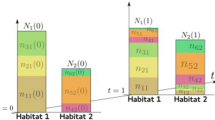Abstract
We investigate the effects of migration pattern on the reduction in metapopulation fitness due to deleterious mutations. Using a matrix approach and stochastic simulations we explore the case of a metapopulation consisting of two and three populations. Both in the long and in the short-term, the viability of a two-populations system depends strongly on the symmetry of exchange, i.e. metapopulation viability is maximized when the number of migrants sent equals the number of migrants received in each population. For a three-population system, the same principle holds in the few cases explored, but a complete demonstration is still needed. In other terms, a very unfavorable situation occurs when a population that receives few migrants is a major source of migrants for the other populations. In conclusion, low but symmetrical number of migrants leads to higher viability than higher but asymmetrical number of migrants. Assuming that it is easier to decrease than to increase the number of migrants, a reasonable management option in the case of unequal number of migrants, could, therefore, be to decrease the higher ones.
Similar content being viewed by others
References
NH Barton MC Whitlock (1997) The evolution of metapopulations I Hanski ME Gilpin (Eds) Metapopulation Biology Academic San Diego 182–197
P Beier RF Noss (1998) ArticleTitleDo habitat corridors provide connectivity? Conserv. Biol. 12 1241–1252
JH Brown A Kodric-Brown (1977) ArticleTitleTurnover rates in insular biogeography: effect of immigration on extinction Ecology 58 445–449
JL Cherry (2004) ArticleTitleSelection, subdivision and extinction and recolonization Genetics 166 1105–1114
B Colas I Olivieri M Riba (1997) ArticleTitleCentaurea corymbosa, a cliff-dwelling species tottering on the brink of extinction: a demographic and genetic study Proc. Natl. Acad. Sci. U 94 3471–3476
Couvet D (2002) The deleterious effects of inbreeding in the case of population fragmentation. Conserv. Biol. (in press).
JF Crow M Kimura (1970) An Introduction to Population Genetics Theory Alpha editions Minneapolis, USA
DM Debinski RD Holt (2000) ArticleTitleA survey and overview of habitat fragmentation experiments Conserv. Biol. 14 342–355
L Fahrig G Merriam (1985) ArticleTitleHabitat patch connectivity and population viability Ecology 66 1762–1768
S Glémin J Ronfort T Bataillon (2003) ArticleTitlePatterns of inbreeding depression and architecture of the load in subdivided populations Genetics 165 2193–2212
A Gonzalez JR Lawton FS Gilbert TM Blackburn I Evans-Freke (1998) ArticleTitleMetapopulation dynamics and distribution in a microecosystem Science 281 2045–2047
I Hanski O Ovaskainen (2000) ArticleTitleThe metapopulation capacity of a fragmented landscape Nature 404 755–758 Occurrence Handle10.1038/35008063
I Hanski J Pöyry T Pakkala M Kuussaari (1995) ArticleTitleMultiple equilibria in metapopulation dynamics Nature 377 618–621
I Hanski DS Simberloff (1997) The metapopulation approach, its history, conceptual domain and application to conservation I Hanski ME Gilpin (Eds) Metapopulation Biology Academic San Diego 5–26
S Harcourt (1991) ArticleTitleEndangered species Nature 354 10
PW Hedrick (1995) ArticleTitleGene flow and genetic restoration: the Florida panther as a case study Conserv. Biol. 9 996–1007
G Hess (1994) ArticleTitleConservation corridors and contagious disease: a cautionary note Conserv. Biol. 8 256–262
K Higgins M Lynch (2001) ArticleTitleMetapopulation extinction caused by mutation accumulation Proc. Natl. Acad. Sci. U. 98 2928–2933
TJ Kawecki R Holt (2002) ArticleTitleEvolutionary consequences of asymmetric dispersal rates Am. Nat. 160 333–347
DA Levin (1988) ArticleTitleConsequences of stochastic elements in plant migration Am. Nat. 132 643–651
M Lynch W Gabriel (1990) ArticleTitleMutation load and the viability of small populations Evolution 44 1725–1737
M Lynch J Conery R Bürger (1995a) ArticleTitleMutation accumulation and the extinction of small populations Am. Nat. 146 489–518
M Lynch J Conery R Bürger (1995b) ArticleTitleMutation meltdowns in sexual populations Evolution 49 1067–1080
DW MacDonald (1996) ArticleTitleDangerous liaisons and disease Nature 379 400–401
MA MacPeek RD Holt (1992) ArticleTitleThe evolution of dispersal in spatially and temporally varying environments Am. Nat. 140 1010–1027
SH Margan RK Nurthen ME Montgomery LM Woodworth EH Lowe DA Briscoe R Frankham (1998) ArticleTitleSingle large or several small? Population fragmentation in the captive management of endangered species Zoo Biol. 17 467–480
LS Mills FW Allendorf (1996) ArticleTitleThe one-migrant-per-generation rule in conservation and management Conserv. Biol. 10 1509–1518
T Nagylaki (1979) ArticleTitleThe island model with stochastic migration Genetics 91 163–176
A Robert D Couvet F Sarrazin (2003) ArticleTitleRole of local adaptation in metapopulation restorations Ani. conserv. 6 1–10
I Saccheri M Kuussaari M Kankare P Vikman W Fortelius I Hanski (1998) ArticleTitleInbreeding and extinction in a butterfly metapopulation Nature 392 491–494
D Simberloff (1988) ArticleTitleThe contribution of population and community biology to conservation science Annu. Rev. Ecol. Syst 19 473–511
M Slatkin (1985) ArticleTitleGene flow in natural populations Annu. Rev. Ecol. Syst 16 393–430
PT Spieth (1974) ArticleTitleGene flow and genetic differentiation Genetics 78 961–965
A Storfer (1999) ArticleTitleGene flow and endangered species translocations: a topic revisited Biol. Conserv. 87 173–180
JA Vucetich T Waite (2000) ArticleTitleIs one migrant per generation sufficient for the genetic management of fluctuating populations Ani. Conserv. 3 261–266
MC Whitlock NH Barton (1997) ArticleTitleThe effective size of a subdivided population Genetics 146 427–441 Occurrence Handle1:STN:280:ByiB1c7nt1c%3D Occurrence Handle9136031
MC Whitlock (2002) ArticleTitleSelection, load and inbreeding depression in a large metapopulation Genetics 166 1191–1202
Author information
Authors and Affiliations
Corresponding author
Rights and permissions
About this article
Cite this article
Bouchy, P., Theodorou, K. & Couvet, D. Metapopulation viability: influence of migration. Conserv Genet 6, 75–85 (2005). https://doi.org/10.1007/s10592-004-7744-7
Received:
Accepted:
Issue Date:
DOI: https://doi.org/10.1007/s10592-004-7744-7




